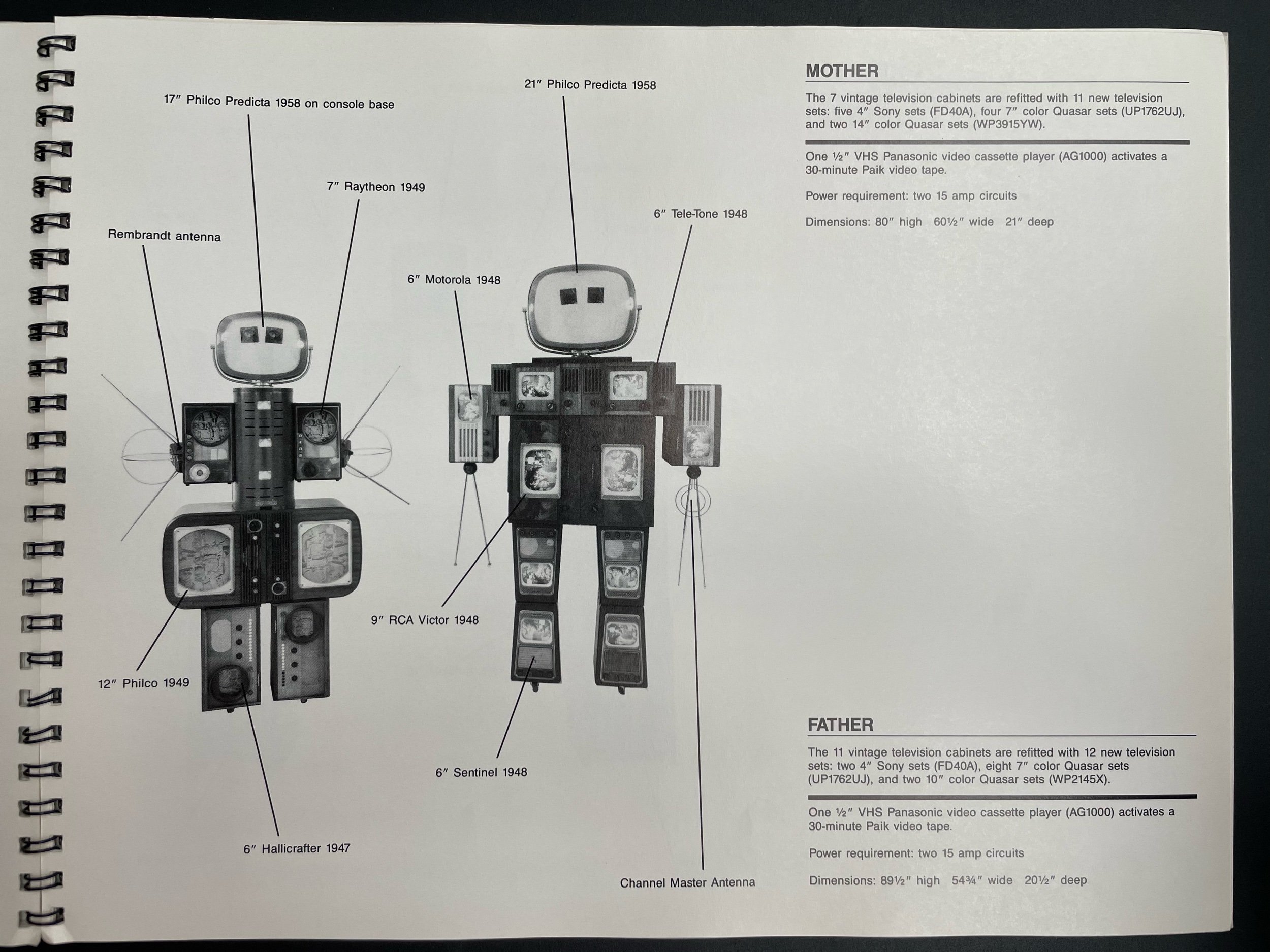Family of Robot (1986)
Family of Robot catalogue published for the premier exhibition of Family of Robot: Mother, Family of Robot: Father, and Connection at the Carl Solway Gallery, Booth 6-125, Chicago International Art Exposition, May 8-13, 1986, Navy Pier, Chicago.
Images used with permission of the Carl Solway Gallery, Cincinnati, Ohio, USA
Here’s a quick primer on Nam June Paik: He was a founding member of experimental art group FLUXUS; He’s widely considered to be the Father of video art; He coined the phrase “electronic super highway” fifteen years before the first web browser was even available. Paik was so far ahead of his time that he didn’t just influence the world of art, his art influenced the use of technology in popular culture as we know it today. But when I think of Nam June Paik, I always, ALWAYS, think of one thing first: Robots.
In 1986 Paik debuted Family of Robot, containing three generations of anthropomorphic robots constructed from antiquated wooden TV cabinets and Bakelite radio consoles. I was completely unaware of these at the time, because I was in the last gasp of my preteen adolescence, spending summers at my grandparents house watching cartoons about my favourite toys, The Transformers, on TV sets that looked a lot like the ones Paik would incorporate into his work.
Unlike the ‘robots in disguise’ that I was so fond of, Paik’s creations didn’t shapeshift into cars or airplanes. They didn’t shoot lasers and weren’t involved in intergalactic battles. In mid-80s pre-teenage boy terms, they were even less threatening than GoBots, and that’s a huge part of their charm.
The original Family of Robot included Grandparents, Parents, baby and an Aunt & Uncle. The elder generations were made from the oldest cabinetry and parts. Figures became progressively more modern and futuristic looking as you worked your way down the family tree. Female robots tended to utilise rounded display cabinets to set them apart from the boxy, hard edged Males, but all of them were augmented with waving poses and smiling faces, some occasionally painted directly onto the displays. Well, at least the displays that weren’t in use. Behind the antiquated cabinetry, the innards had been gutted and re-fitted with what were state of the art TV displays at the time of their creation, enabling the appendages to display Paik’s video art, which he used like paint.
Quite often, the point of Paik’s videos wasn’t for you to explicitly watch the screens. The point was for the video on the screens to add texture and intrigue into whatever object they were embedded. Images and static would be interwoven via fast edits into a non-linear video-scape that wasn’t necessarily about any particular message. His early video art was frenetic and full of energy, and had a direct influence on MTV. It is that style of editing you will see in the limbs of his robots.
I can’t recall how or when I first became aware of these works, but I can still distinctly recall the first time I stood amongst them in a museum.
In 1994 a touring exhibition brought Family of Robot to my hometown. I caught the show while home from college on winter break. I still remember how big and bulky they were — often taller than me! Yet they looked so friendly and inviting, waving at me while a cacophony of colours and sounds echoed off the museum walls as their dozens of TV screens flashed hyperkinetic montages. These futuristic beings that lurked around every corner of the museum simultaneously hit me with visions of a media saturated future and a heavy sense of nostalgia.
Paik would continue to make and evolve these ‘found object’ robots throughout his career. Sometimes they would be entirely unique creations with distinct personalities. Other times they were inspired by, or even intended to be an homage to, famous figures or his real life art friends. Regardless of the subject, in my eyes Paik’s robots had managed to mashup my favourite futuristic childhood toy with my Grandparent’s living room and I couldn’t get enough of them.
I’ve often wondered if my fascination with these works is due to that childhood nostalgia, or just me succumbing to an innate stereotype / bias about boys liking tech toys. Probably a bit of both, although it’s worth noting that these works were not intended to be gendered focus art. They aimed to speak to all of society. In the 80’s, futuristic visions of media saturation or technological advancements tended to be dystopian. Paik took a different approach. He embraced technology with curiosity, optimism and a mischievous sense of fun. He was fascinated by technology’s potential, and acutely aware of its implications. Maybe that’s why he chose to shape these figures of the future using antiquated shells to look like a familiar family waiting to embrace you with a hug. Oh, if only I had been allowed to!
That’s why I like it.
They’re more than meets the eye.
Additional reading:
Previously, on Why I Like It:
Sep — H2O (2005), Vassilis Karakatsanis
Aug — Composition C (No.III) with Red, Yellow and Blue (1935), Piet Mondrian





